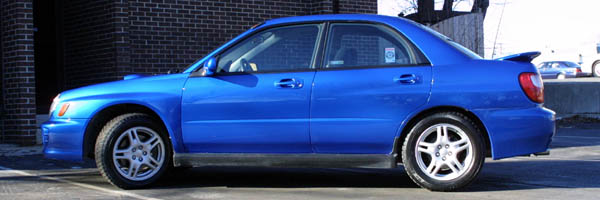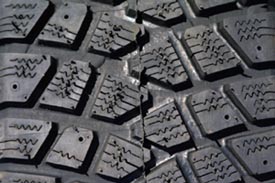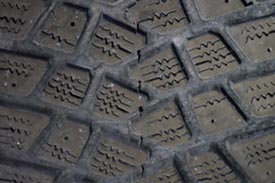article by Jacoby O'Connor
A Subaru Enthusiast
www:Subdriven.com


| by: Jacoby O'Connor |
Last edited:
02.01.03 |
While driving the snow covered logging roads of Michigan’s
Upper Peninsula during the Lake Superior Pro Rally this last
October, I realized that the stock all-season tires with 20k
miles on them weren’t going to cut it for another winter.
Especially the way I drive.
After looking into numerous brands, one very interesting recommendation
came my way. Green Diamond’s. That one was new to me,
and for good reason. This tire company was new to North America
and for all intents and purposes the World. Green Diamond tires
are the work of an Icelandic company by the name of New Industries
Ltd., who took the concept of embedding tiny metal granules
evenly throughout the tread of a tire, and put it into mass
production. Formed in 1995, New Industries Ltd., went from
selling 3,000 tires in Sweden in 1998-1999 to 15,000 tires
in 1999-2000. Green Diamond North America began selling it’s
tires in upstate New York and has now spread to the North East
and Midwest.
The Green Diamond tire is a process in which hard carbide granules
are distributed evenly throughout the tires tread. These granules
are made of silicium carbide and aluminum oxide, the same material
contained in industrial diamonds for use in grinders and sprockets.
That explains the “Diamond” aspect to the name,
but what about the “Green”? Quite simply put, these
tires are environmentally friendly because they are in fact
a retread, meaning for every tire sold there is one less tire
sent to the landfills. On top of that, because these granules
fall out once the surrounding rubber has worn away exposing
new granules, they don’t damage the road surface like
studded tires do. For that reason these tires can be used in
states where studded tires have been banned.
|
With several different styles of Green Diamond snow tires to choose from, I went with the Inari, Green Diamond’s most aggressive winter tread. Two days after ordering, my tires arrived via FedEx. When you first receive the Green Diamonds, there are no signs of tiny carbide granules. You must run these tires on dry pavement for around 500 to 1000 km (300 to 600 miles) in order to wear off the thin layer of rubber covering the granules. With no snow in the immediate forecast I knew I would have ample time to break them in. On dry pavement the initial difference was hugely noticeable. The car sat at least an inch higher and in turns the response to the wheel was noticeably slower. None of these issues came as a real surprise to me considering this tire is listed as a dedicated snow tire. It didn’t take long before I got use to the different feel and was confident in taking turns with a bit more spirit.
After about 400 miles the granules were fully exposed and unfortunately, there was still no snow in the forecast.
December gave me the opportunity to test out the Green Diamonds in the dirt, at a rally cross in Central Wisconsin. In the previous five rally crosses I competed in, I ran the stock Brigestone RE92’s on my WRX. From the launch of my first run I knew that I was dealing with an entirely different animal. Instead of launching my car at 3,500 rpm and having it spin in place for a second, it hopped up out of the dirt and made it’s way into the dirt oval that made up a large section of this course. As I came into the first long turn I wasn’t able swing out the back end of the car as easily as I was use to doing with the RE92’s. I was amazed. So this is what it feels like to have control during a drift. The Green Diamonds took quite a beating during the first couple of heats, climbing their way out of ruts and deep sandy dirt.
|

Overall, I was pleased with how they handled in the dirt, but on Christmas Eve I was given an early Christmas present and finally had the opportunity to test the Inari’s in their intended conditions. The 2” of snowfall was just enough to get a good idea of just how big of a difference the Green Diamonds would make. I headed out in search of a large empty parking lot and came upon a vacant car lot covered with a virgin layer of lovely white snow. After doing some playing around with drifting and “Subynuts” I tried a few launches. I was able to launch at around 3k rpm and felt very little slip occurring and the car managed to stay straight as opposed to the normal sideways motion that would normally occur in these conditions. Into the turns the traction was night and day compared to the RE’92’s, allowing me to drive a controlled slalom with little to no under steer. Understeer had always been my most common problem in snowy conditions, so this was a major plus. Braking was the last test for the night, and though a great improvement from the RE92’s, this was the most difficult difference to gauge compared to the previous maneuvers. With all these reasons to switch to Green Diamonds for winter driving, one thing had yet to be determined, whether or not any of these improvements could be attributed to the tiny carbide granules embedded in the tread.
The one place where this question could be answered was on solid ice. So I went where I could be guaranteed a true ice driving test. Lake Sinissippi, in Hustisford, Wisconsin, for the Wisconsin Autosport Group’s Ice Trials II. A timed rally cross held in the middle of a frozen lake. I had the opportunity to see every level of tire on the 50+ cars that came out to the lake to race. From WRX’s running the Stock RE92’s to full rally prepped Mitsubishi Eclipse with Ice Studs. Watching the cars run with ice studs was amazing. They looked like they were running on gravel. They had unbelievable amounts of traction. I had no aspirations of this much control. However, I found that I had enough traction to launch and accelerate without too much spinning of the tires. Turning on this clean ice was challenging at any substantial speed, but at lower speeds I was able to control the car with reasonable confidence. Drivers running normal snow tread tires reported more control trouble that those who were running Green Diamond’s didn’t experience. Those who were running all-season tires had to drive painfully slow in order not to spin off the course. In the end, there was a noticeable advantage to the Green Diamonds vs. normal snow tires. While no substitute for fully studded tires, you can legally drive on Green Diamonds in areas where studded or chained tires are not allowed.
The Green Diamond Inari’s have me looking forward to snow for the first time since I was a kid who knew nothing more than making snow forts and sledding. Driving without snow tires in winter is a thing of the past for me now, and with the benefits of price, traction, and environmental friendliness, the Green Diamonds seem like a great choice. |
|





